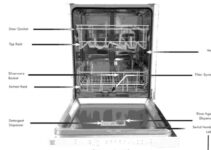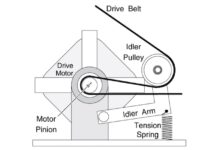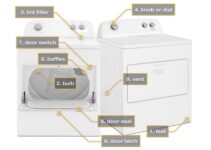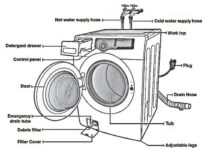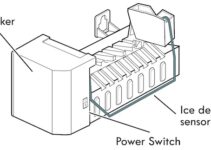The Kenmore model 110 washer is a common appliance used in many homes. This machine is known for its reliability and efficiency, though it may need the occasional repair.
In addition to the washer’s spin cycle, which centrifugally removes water from clothing, the model 110 also has a cold-water wash mode intended to help dissolve detergent more quickly and evenly around your laundry.
Kenmore Washer Model 110 Parts Diagram
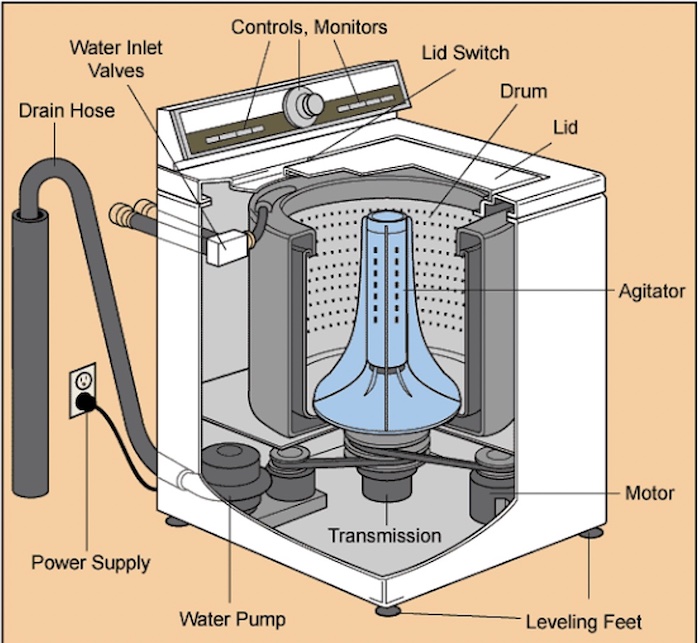
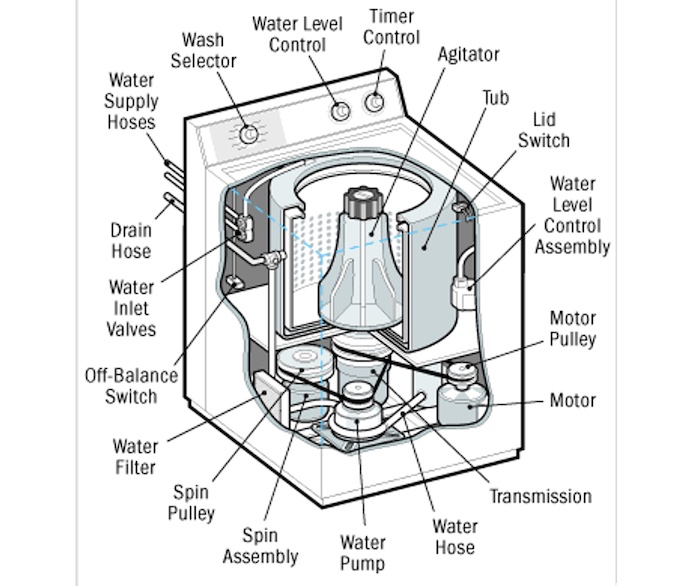
The main components of Kenmore washer model 110 include: a drum (or tub), top loader, agitator assembly with impeller blades supported by bearing rollers affixed to a support plate; motor control board; level sensor; control panel with a display screen showing status indicators; drain pump assembly; motor drive belt pulley with idler gear attached to it
Kenmore Washer Model 110 Parts & Their Functions
Control Panel
The control panel is located on top of the washer. It has buttons that select wash cycles, set the timer, and display information such as water level and spin speed.
The Lid
The lid is the topmost part of your Kenmore Washer Model 110. You place your clothes and other laundry accessories, such as detergent, fabric softener, and bleach.
The lid comprises two parts: a front panel with four hinges that allow it to open outwardly; and a rear panel with two hinges that helps keep it closed when not in use.
Mixer Cap
The mixer cap is made of plastic and is located in the center of the washer tub. It’s part of an agitator assembly that mixes detergent with water, which helps to clean clothes better.
Kenmore Model 110 Motors
The Kenmore Model 110 motors are well-known for their reliability and efficiency. They may need occasional repair, but they’re easy to maintain. The motor is located in the bottom of the washer, connected to its transmission assembly unit via a belt and pulley system that runs through your walls, floors, and basement!
Transmission Assembly Unit
The transmission assembly unit is located on the side of your washer. It has two gears, one that runs your spin cycle and one that helps with agitation. The transmission assembly unit also has an arm that holds the motor in place when you’re not using it.
You can replace this part yourself if it becomes damaged or worn out over time by following these steps:
- Turn off the power to your washer before beginning any repairs
- Disconnect all electrical connections from inside of your machine (including water hoses) using a screwdriver or pliers
- Remove two screws holding down the plastic cover on top of the unit housing; then pull up firmly until the cover comes off completely
Basket Assembly
The basket assembly is a collection of parts that hold the clothes and move them through the washer. This includes a basket, agitator, agitator shaft, and door switch. The basket holds all your laundry items in one place so they can be washed individually or together.
The agitator is what spins around to mix water with soap powder for cleaning purposes. It also has an impeller inside, which moves water from one part of your machine to another (like when you’re filling up with water).
Gasket Assembly
The gasket assembly is a plastic piece that surrounds the drain pump, drain hose, and tub seal. It also has a rubber seal to keep water from leaking from your machine.
Drain Pump Gasket
This comprises two parts: one for each side of the pump. The top part fits into its corresponding hole in the washer’s housing while the bottom part sits on top like a lid over an open jar.
Drain Pump Seal
This piece seals around both ends of your pump so no water can escape through openings between them (or between what otherwise would be open space).
Tub Seal Gasket
This one goes around all four sides where our tub meets its frame/frame rail; this ensures there won’t be any leaks along those areas either!
Drain pump
The drain pump is what removes the water from the tub after the wash cycle. It’s located in the back of your Kenmore Washer and attached to the bottom of your tub.
Water pump
The water pump is a part of the washer that circulates water through the machine. It’s usually located on the left side of your Kenmore washer, near the bottom. The water pump is a small motor connected to a pulley and spins when you turn on your washing machine.
Door boot
The door boot is the part of your washer that covers the top of the door. If it breaks, you’ll need to replace it with one from Kenmore’s parts department.
Lid switch
The lid switch is located in the control panel. It’s a safety device that prevents your washer from spinning if you don’t close the lid properly. The switch can be replaced if it is defective, but we recommend having it tested with a multimeter before doing so.
Leveling leg
The leveling leg is a small metal rod that extends from the front of the washer through your tub and into the back. It’s used to level out any irregularities in your floor, so you can be sure that water will flow evenly throughout your machine.
Transmission
The transmission is the main drive system that transfers power from the motor to the tub. It’s a metal shaft with plastic, metal, and rubber parts that allow it to move smoothly through its housing. The transmission can be lubricated by oil or grease; however, it’s always advisable to use synthetic oil when washing your clothes to keep things running smoothly.
Tub support spring
The tub support spring is a small, flat piece of metal that sits between the bottom panel and the tub itself. It helps to keep your washer balanced, which is important for preventing damage to both parts when you’re washing clothes. If this spring breaks, your Kenmore washer may become unbalanced and vibrate or shake too much during use.
Agitator coupler and assembly
The agitator coupler and assembly connect the agitator to the transmission. It consists of two parts, an agitator coupler, and an agitator drive hub.
The coupler fits into a groove on your washer’s transmission housing (or drum), while its drive hub attaches to an internal gear that connects with other components within your machine.
Basket drive hub and bearing kit
The basket drive hub and bearing kit is the part of your washer that connects to your drain hose. This connection is important because it allows water to exit from one side of the machine and enter through another, effectively washing clothes.
Washer Drive System
The washer drive system is the mechanism that transfers energy from the motor to the tub. Most washers have a direct-drive system, which means the motor is connected directly to the tub. This system requires less maintenance and has fewer moving parts than other types, but it can be more expensive if you choose an expensive brand.
Washer Water Level Switch
The washer water level switch is located in front of the washer. It’s a small, round knob that you turn to raise or lower your washing machine’s water level.
The temperature selector switch is on top of your Kenmore washer and allows you to select from three temperatures: cold rinse, warm rinse, and sanitary cycle (or “no heat”).
Washer Temperature Switch
The temperature switch is a safety device that prevents the washer from overheating. It’s located on the back of your Kenmore washer and allows you to set a safe temperature range for your machine. If you don’t want this particular setting, unplug it and keep cleaning!
Washer Cycle Selector Switch
The washer cycle selector switch is a mechanical switch that is used to select the wash or rinse cycle, and it’s located on the top of your control panel. It has three positions: wash, rinse, and spin.
When you press this little button in any direction (up or down), it will allow you to choose your desired load size (smallest/largest). When pressed halfway between those two settings, it will change automatically from one setting to another based on what’s happening inside your machine—for example, if clothes are being washed, but no water is left in them. They’ll get spun dry before they’re emptied into the spinning basket where all those nasty little things go who that likes talking about because they’re not nice people who like themselves too much!
Conclusion
The washer has been a staple in American households for over 60 years. It has changed little since its launch, but as with any appliance, there’s always room for improvement. Since the model 110 was introduced, we’ve seen updates to its control panel, lid switch, and water pump—all of which are designed to keep your family happy and clean!
